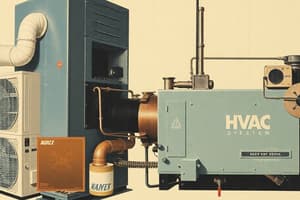Podcast
Questions and Answers
______ refers to the total amount of heat that needs to be added to a space to maintain a desired temperature.
______ refers to the total amount of heat that needs to be added to a space to maintain a desired temperature.
Space Heat Load
To maintain comfort or efficiency, cooling systems are required to remove excess heat generated by ______.
To maintain comfort or efficiency, cooling systems are required to remove excess heat generated by ______.
heat sources
______ is a person’s subjective satisfaction with the temperature and other environmental factors around them.
______ is a person’s subjective satisfaction with the temperature and other environmental factors around them.
Thermal comfort
Higher ______ generally require more cooling, while lower temperatures necessitate more heating to maintain thermal comfort.
Higher ______ generally require more cooling, while lower temperatures necessitate more heating to maintain thermal comfort.
Physical activity increases heat production within the body, thus increasing the ______, requiring increased cooling.
Physical activity increases heat production within the body, thus increasing the ______, requiring increased cooling.
Direct ______ can significantly increase heat load on a building, influencing thermal comfort and energy consumption.
Direct ______ can significantly increase heat load on a building, influencing thermal comfort and energy consumption.
Factors such as insulation and window placement in ______ design and construction play a crucial role in heat gain and loss, affecting the building's energy efficiency.
Factors such as insulation and window placement in ______ design and construction play a crucial role in heat gain and loss, affecting the building's energy efficiency.
When the ventilation air is humid, the air conditioning system has to work harder to remove ______ from the air, impacting cooling load.
When the ventilation air is humid, the air conditioning system has to work harder to remove ______ from the air, impacting cooling load.
If the ______ air is warmer than the indoor air, the system must also cool it down to maintain the desired indoor temperature, which determines the sensible load.
If the ______ air is warmer than the indoor air, the system must also cool it down to maintain the desired indoor temperature, which determines the sensible load.
When the outdoor air is colder than the indoor air, the HVAC system has to use more energy to heat it up to maintain ______ levels, thereby increasing the heating load.
When the outdoor air is colder than the indoor air, the HVAC system has to use more energy to heat it up to maintain ______ levels, thereby increasing the heating load.
Flashcards
Heating Load
Heating Load
The total heat needed to maintain a desired temperature in a space.
Cooling Load
Cooling Load
The amount of heat that must be removed to maintain a comfortable temperature.
Internal Heat Gains
Internal Heat Gains
Heat produced within a space from occupants, equipment, and lighting.
Thermal Comfort
Thermal Comfort
Signup and view all the flashcards
Factors Affecting Thermal Comfort
Factors Affecting Thermal Comfort
Signup and view all the flashcards
Thermal Sensitivity
Thermal Sensitivity
Signup and view all the flashcards
Building Design Impact
Building Design Impact
Signup and view all the flashcards
Energy Consumption
Energy Consumption
Signup and view all the flashcards
Low Impact Refrigerants
Low Impact Refrigerants
Signup and view all the flashcards
Study Notes
Heating and Cooling Load
- Heating and cooling load is the amount of energy needed to adjust a space's temperature to a desired level.
- HVAC (Heating, Ventilation, and Air Conditioning) systems are used to provide the desired level of comfort.
Space Heat Load Items
- Space heat load is the total heat needed to maintain a desired temperature.
- It includes occupant body heat, lighting fixtures, appliances, solar radiation through windows, heat gain from walls and roof, air infiltration, and heat generated by equipment.
Key Components of Space Heat Load
- Internal heat gains from people
- Lighting
- Appliances and equipment
- Solar radiation
- Building envelope heat transfer
- Infiltration air
- Ventilation air
Factors Affecting Space Heat Load
- Climate conditions
- Building design
- Occupancy patterns
- Equipment usage
Heat Sources for Cooling Load
- Heat sources are any element or process generating heat, raising the temperature of a space or system.
- Cooling systems are needed to remove this excess heat for comfort and efficiency.
- Examples of heat sources:
- Occupants (body heat)
- Lighting (incandescent and some fluorescent lights)
- Electrical equipment (computers, appliances, machinery)
- Solar gain (sunlight entering through windows)
- External heat (heat from surrounding environments)
Factors Affecting Thermal Comfort
- Environmental Factors:
- Air temperature: higher temperatures need more cooling; lower temperatures need more heating.
- Personal Factors:
- Metabolic rate: physical activity increases heat production.
- Clothing insulation: clothing acts as a barrier affecting heat exchange.
- Individual variations: different sensitivities, preferences, ages, and health conditions affect comfort levels.
- Other Factors:
- Solar radiation: direct sunlight increases heat load.
- Building design and construction: insulation, window placement, and shading devices affect heat gain and loss.
- Ventilation: proper ventilation removes excess heat and moisture, improving air quality and thermal comfort.
Environmental Factors (Energy Consumption)
- Higher cooling demand leads to increased energy consumption.
- Larger temperature differences between inside and outside a building require more energy for air conditioners.
- Regular maintenance improves system efficiency and reduces energy use.
- Clean air ducts in air conditioners improves air transfer efficiency.
Environmental Factors (Low-Impact Refrigerants)
- Using low-impact refrigerants helps decrease the environmental impact of air conditioning.
Ventilation Air (Cooling Load)
- Latent Load: Humid ventilation air requires extra work from the AC to remove moisture.
- Sensible Load: Warmer ventilation air necessitates cooling to maintain indoor temperature.
Heating Load
- When outdoor air is colder than indoor air, HVAC systems use more energy for heating.
Studying That Suits You
Use AI to generate personalized quizzes and flashcards to suit your learning preferences.




